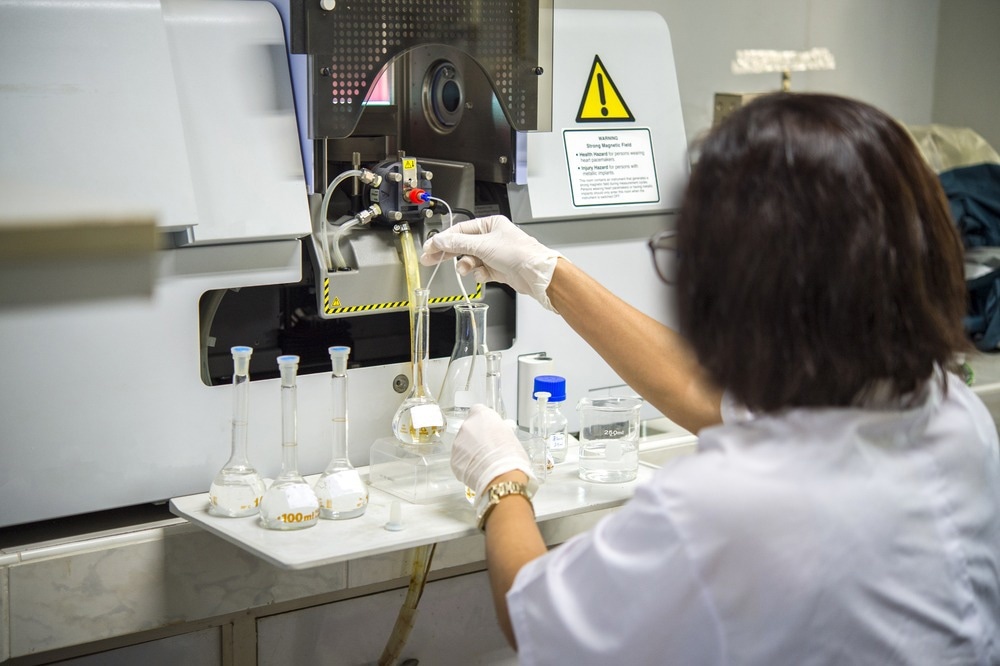Spectroscopy and spectrometry are terms that are often used interchangeably but there are some subtle differences in their exact meanings. The International Union of Pure and Applied Chemistry’s (IUPAC) Gold Book – the ‘Compendium of Chemical Terminology’ – defines spectroscopy as ‘the study of physical systems by the electromagnetic radiation with which they interact or that they produce.’1

Image Credit: Rabbitmindphoto/Shutterstock.com
The IUPAC Gold Book definition of spectrometry, however, is the following: ‘spectrometry is the measurement of such radiations as a means of obtaining information about the systems and their components’1
Examples of techniques known as spectroscopies include optical, infrared, nuclear magnetic resonance (NMR) and Raman. These, and the myriad of other spectroscopic techniques, are ways of using electromagnetic radiation in different ways to learn something new about a molecule or material system.
Probably one of the most widely recognized examples of a ‘spectrometry’ method is mass spectrometry. Mass spectrometry is a method that typically uses an ionization source to generate ions and measure the mass to charge ratio. The reason mass spectrometry is called a spectrometry method and not a spectroscopy method is because it is an analytical technique where the fragmentation pattern is used to analyze the molecule, rather than a direct measurement of the interaction of the molecule with electromagnetic radiation.
The most common types of spectroscopy are absorption or emission-based methods. In absorption, a change in the intensity of the incident radiation after it passes through the sample is used to learn about the electronic, vibrational or rotational structure of the molecule or material.
In emission methods, a sample is irradiated and the photons or other particles emitted are used to recover similar types of information. For certain applications, such as the development of optoelectronic devices like light-emitting diodes, the quantum yield of the emission process may also be of direct interest to the application.
Spectrometers
Recovering the wealth of information to be found in spectroscopy requires performing measurements on samples and this typically involves some type of spectrometer.
A generic spectrometer is any device that measures the variation in a physical characteristic over a defined range.
In the example of a standard scanning UV-vis spectrometer, this would involve measuring the change in the absorption of a sample while the incident wavelength is varied across the visible and UV part of the electromagnetic spectrum.
The change in absorption is measured by a detector that records the variation in the intensity of the incident light and this information can be used to reconstruct the absorption spectrum that can provide useful information on a sample, such as the HOMO-LUMO separation, a key parameter for optoelectronic materials, as well as information about solute-solvent interactions and the electronic structure of the molecule.
Spectrometer designs are as diverse as the numerous types of spectroscopic techniques out there. For example, UV-vis absorption spectroscopy can be performed with both monochromatized beams and by scanning the position of the grating to vary which wavelength of light passes through the slit.
Alternatively, a broadband excitation source can be used with a dispersive spectrometer and array detector post-sample to record a range of the absorption spectrum in a single measurement or shot. Dispersive spectrometers require more expensive detectors but can record spectra significantly faster with no moving parts in wavelength regions where suitable broadband light sources are available.2
The type of detector often used depends on whether photons or charged particles are being detected and also which region of the electromagnetic spectrum the experiment is being performed in.
Charged particle detection and spectrometers often use electromagnetic fields to extract and control the trajectories of the charged particles from the interaction region where they are produced. Phosphor screens and multichannel plates or channel electron multipliers are common examples of detection technologies for such experiments.
Certain types of spectroscopy have been relatively underdeveloped due to the lack of available detection technologies to build spectrometers. For example, terahertz spectroscopy has become a much more widely used methodology owing to the developments in detection technology making new types of experiments possible as well as practical concerns around detector costs and sizes.3 The availability of smaller footprint detectors with lower power draw has also helped the development of a range of handheld spectrometers.
Importance of Spectroscopy
Spectroscopy and spectrometry are now essential tools, both as workhorses in the analytical sciences for quantitative and qualitative measurements but also for fundamental science. Spectroscopy has been key in developing a fundamental understanding of quantum mechanics and providing evidence for many of the hypothesized theories.
The interdependency of spectroscopy and quantum mechanics has led to spectroscopy being described as ‘applied quantum mechanics’.4 Quantum mechanics is necessary to describe many of the observations in spectroscopy, to help develop new methods, and work out what techniques might help explore certain aspects of molecular properties.
Developments in spectrometers are making new spectroscopies possible and with the push for more light-driven technologies, these tools and methodologies will only become ever more important.
To summarize, spectroscopy is the study of the interaction between light and matter, whereas spectrometry refers to the measurement process itself.
References and Further Reading
- IUPAC (2022) Gold Book, https://goldbook.iupac.org/terms/view/S05848, accessed June 2022
- Pena-pereira, F., Costas-mora, I., Romero, V., & Lavilla, I. (2011). Advances in miniaturized UV-Vis spectrometric systems. Trends in Analytical Chemistry, 30(10), 1637–1648. https://doi.org/10.1016/j.trac.2011.04.018
- Sizov, F. (2018). Terahertz radiation detectors: the state-of-art. Semiconductor Science and Technology, 33, 123001. https://iopscience.iop.org/article/10.1088/1361-6641/aae473
- Ball, D. W. (2007) Spectroscopy is Applied Quantum Mechanics, https://www.spectroscopyonline.com/view/spectroscopy-applied-quantum-mechanics-part-i-need-quantum-mechanics, accessed June 2022
Disclaimer: The views expressed here are those of the author expressed in their private capacity and do not necessarily represent the views of AZoM.com Limited T/A AZoNetwork the owner and operator of this website. This disclaimer forms part of the Terms and conditions of use of this website.